Avoid having your email stolen via "Please find attached receipt" phishing email
Phishing/ScamAlso Known As: Please find attached receipt phishing email
Get free scan and check if your device is infected.
Remove it nowTo use full-featured product, you have to purchase a license for Combo Cleaner. Seven days free trial available. Combo Cleaner is owned and operated by RCS LT, the parent company of PCRisk.com.
What is "Please find attached receipt" email scam?
After analyzing the "Please find attached receipt" email, we determined that it operates as a phishing scam. This letter promotes a website disguised as an email sign-in webpage that targets account log-in credentials (i.e., passwords).
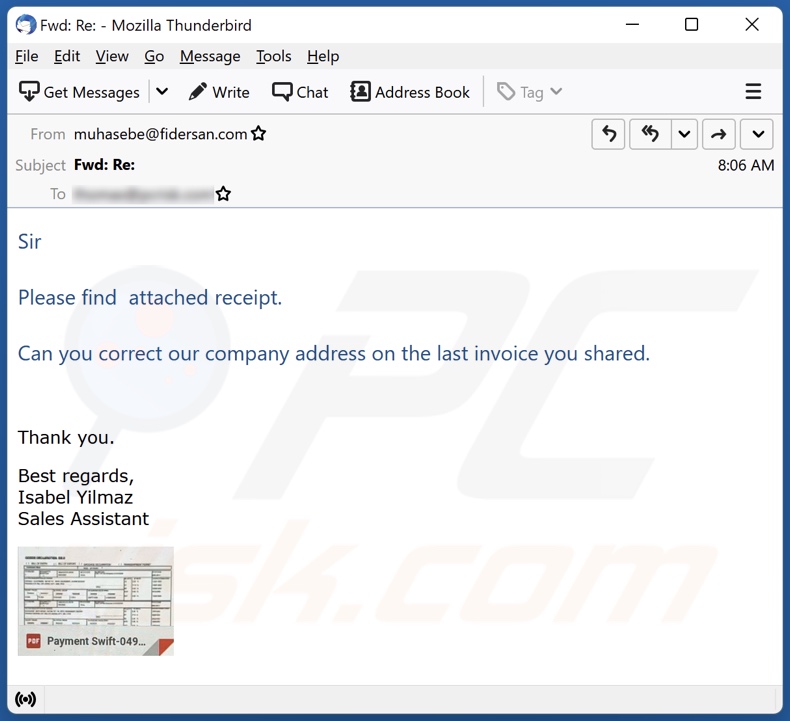
"Please find attached receipt" email scam overview
The spam email requests the recipient to provide corrections to their company address on the shared invoice. The letter contains an image of a PDF file, which after being clicked, redirects to a phishing site. It is presented as a sign-in page requesting users to log in using their email account credentials.
It must be emphasized that both this letter and the promoted website are fake. The information (i.e., password) entered into the webpage is disclosed to the scammers behind this spam campaign. With this data in their possession, the cyber criminals can gain control over the exposed email accounts and the content associated with them.
Hence, platforms, services, and similar that were registered using the email - might be at risk of unauthorized access as well. For example, scammers can use stolen communication accounts (e.g., emails, messengers, social networking, etc.) to ask the contacts for loans - under the guise of the genuine owner.
Additionally, social platforms can be employed to proliferate malware by sharing malicious files and links. Finance-related accounts (e.g., online banking, e-commerce, digital wallets, etc.) can be used to make fraudulent transactions and online purchases.
To summarize, by trusting emails like "Please find attached receipt" - users can experience severe privacy issues, financial losses, and identity theft.
| Name | Please find attached receipt phishing email |
| Threat Type | Phishing, Scam, Social Engineering, Fraud |
| Fake Claim | Email requests recipients to correct their company address provided in their last invoice. |
| Related Domains | gamemodx[.]cf |
| Detection Names (gamemodx[.]cf) | alphaMountain.ai (Phishing), Combo Cleaner (Malware), CRDF (Malicious), G-Data (Malicious), Lionic (Phishing), Full List Of Detections (VirusTotal) |
| Serving IP Address (gamemodx[.]cf) | 172.67.187.44 |
| Symptoms | Unauthorized online purchases, changed online account passwords, identity theft, illegal access of the computer. |
| Distribution methods | Deceptive emails, rogue online pop-up ads, search engine poisoning techniques, misspelled domains. |
| Damage | Loss of sensitive private information, monetary loss, identity theft. |
| Malware Removal (Windows) |
To eliminate possible malware infections, scan your computer with legitimate antivirus software. Our security researchers recommend using Combo Cleaner. Download Combo CleanerTo use full-featured product, you have to purchase a license for Combo Cleaner. 7 days free trial available. Combo Cleaner is owned and operated by RCS LT, the parent company of PCRisk.com. |
Similar spam campaign examples
"Trezor email scam", "We are closing all mailbox users", and "DHL - YOUR GOODS ARE IN TRANSIT", are just a few examples of the phishing emails we have analyzed recently.
Spam mail is not used exclusively for scams, it is also employed in malware proliferation (e.g., trojans, ransomware, cryptominers, etc.). Due to how widespread this mail is, we strongly advise exercising caution with incoming emails and messages.
How do spam campaigns infect computers?
Spam emails can have infectious files attached to and/or linked inside them. These files can be in various formats, e.g., Microsoft Office and PDF documents, archives, executables, JavaScript, etc. When such a file is opened - the infection process is jumpstarted. For example, Microsoft Office documents cause infections by executing malicious macro commands.
How to avoid installation of malware?
We strongly advise against opening the attachments and links present in suspicious/irrelevant emails and messages - as that can cause malware infections. Additionally, it is important to use Microsoft Office versions released after 2010 since they have the "Protected View" mode that prevents automatic execution of macro commands.
However, malicious software is not spread exclusively via spam mail. Therefore, all downloads must be performed from official and verified sources. Furthermore, software must be activated and updated using functions/tools provided by genuine developers, as illegal activation tools ("cracks") and fake updates may cause system infections.
We must emphasize the importance of having a dependable anti-virus installed and updated. Security programs must be used to run regular system scans and to remove detected threats. If you've already opened malicious attachments, we recommend running a scan with Combo Cleaner Antivirus for Windows to automatically eliminate infiltrated malware.
Text presented in the "Please find attached receipt" scam email letter:
Subject: Fwd: Re:
Sir
Please find attached receipt.
Can you correct our company address on the last invoice you shared.
Thank you.
Best regards,
Isabel Yilmaz
Sales Assistant
Screenshot of the phishing website promoted by the "Please find attached receipt" spam campaign:
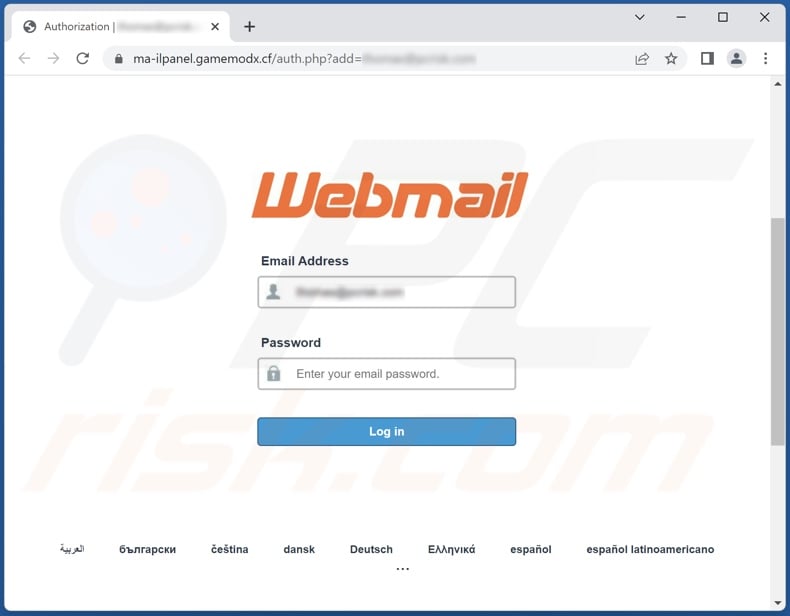
Another example of attached receipt-themed spam email spreading an HTML document used for phishing purposes:
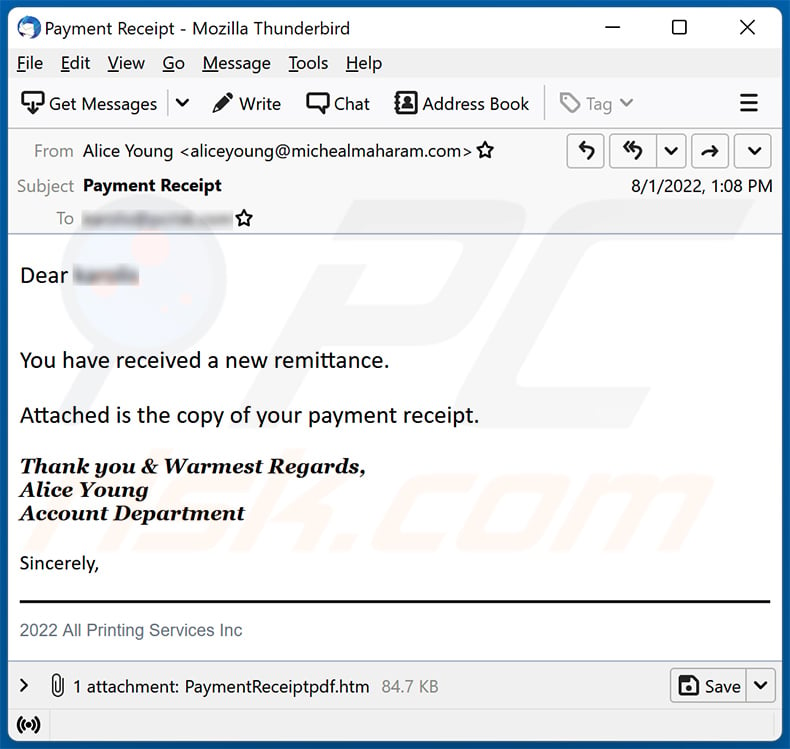
Text presented within:
Subject: Payment Receipt
Dear -
You have received a new remittance.
Attached is the copy of your payment receipt.
Thank you & Warmest Regards,
Alice Young
Account DepartmentSincerely,
2022 All Printing Services Inc
Screenshot of the attached HTML file:
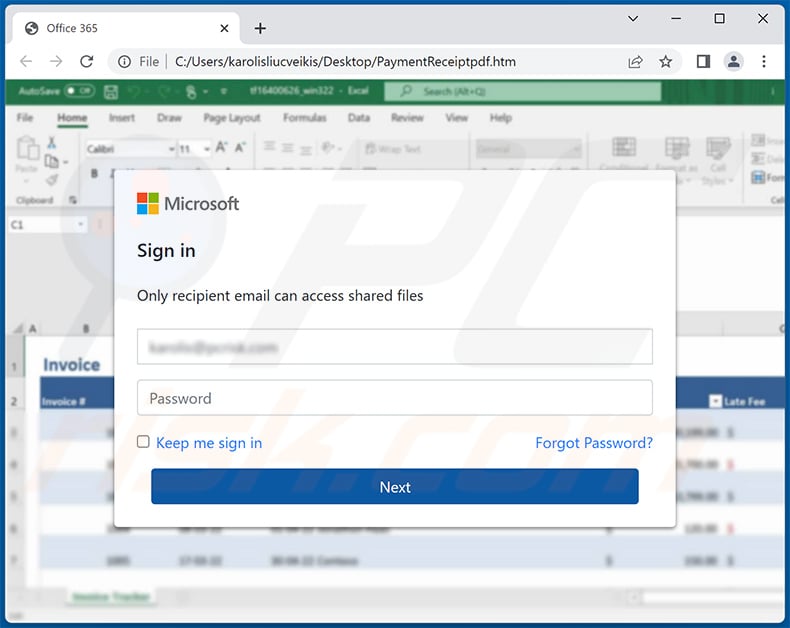
Yet another example of a attached receipt-themed spam email spreading malware:
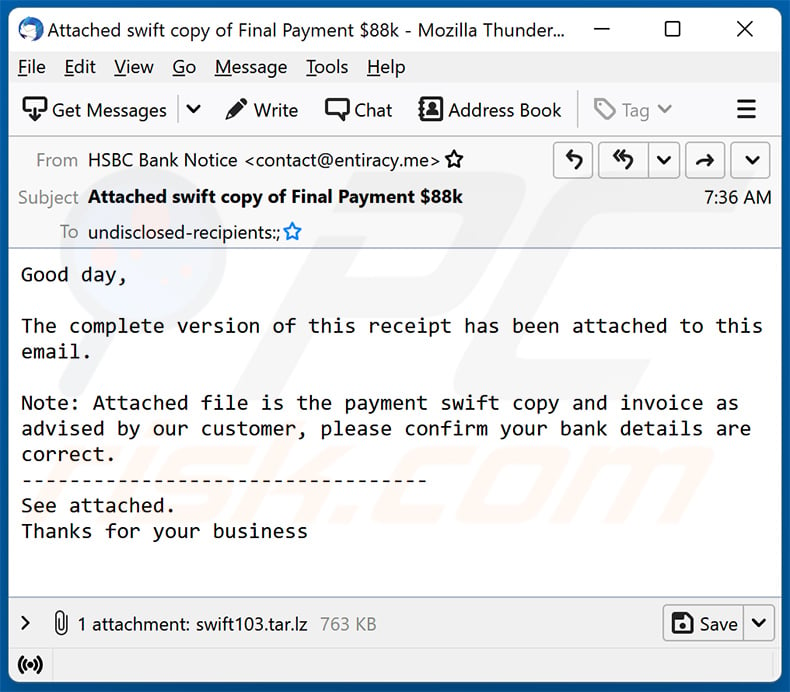
Text presented within:
Subject: Attached swift copy of Final Payment $88k
Good day,
The complete version of this receipt has been attached to this email.
Note: Attached file is the payment swift copy and invoice as advised by our customer, please confirm your bank details are correct.
----------------------------------
See attached.
Thanks for your business
Instant automatic malware removal:
Manual threat removal might be a lengthy and complicated process that requires advanced IT skills. Combo Cleaner is a professional automatic malware removal tool that is recommended to get rid of malware. Download it by clicking the button below:
DOWNLOAD Combo CleanerBy downloading any software listed on this website you agree to our Privacy Policy and Terms of Use. To use full-featured product, you have to purchase a license for Combo Cleaner. 7 days free trial available. Combo Cleaner is owned and operated by RCS LT, the parent company of PCRisk.com.
Quick menu:
- What is Please find attached receipt phishing email?
- Types of malicious emails.
- How to spot a malicious email?
- What to do if you fell for an email scam?
Types of malicious emails:
![]() Phishing Emails
Phishing Emails
Most commonly, cybercriminals use deceptive emails to trick Internet users into giving away their sensitive private information, for example, login information for various online services, email accounts, or online banking information.
Such attacks are called phishing. In a phishing attack, cybercriminals usually send an email message with some popular service logo (for example, Microsoft, DHL, Amazon, Netflix), create urgency (wrong shipping address, expired password, etc.), and place a link which they hope their potential victims will click on.
After clicking the link presented in such email message, victims are redirected to a fake website that looks identical or extremely similar to the original one. Victims are then asked to enter their password, credit card details, or some other information that gets stolen by cybercriminals.
![]() Emails with Malicious Attachments
Emails with Malicious Attachments
Another popular attack vector is email spam with malicious attachments that infect users' computers with malware. Malicious attachments usually carry trojans that are capable of stealing passwords, banking information, and other sensitive information.
In such attacks, cybercriminals' main goal is to trick their potential victims into opening an infected email attachment. To achieve this goal, email messages usually talk about recently received invoices, faxes, or voice messages.
If a potential victim falls for the lure and opens the attachment, their computers get infected, and cybercriminals can collect a lot of sensitive information.
While it's a more complicated method to steal personal information (spam filters and antivirus programs usually detect such attempts), if successful, cybercriminals can get a much wider array of data and can collect information for a long period of time.
![]() Sextortion Emails
Sextortion Emails
This is a type of phishing. In this case, users receive an email claiming that a cybercriminal could access the webcam of the potential victim and has a video recording of one's masturbation.
To get rid of the video, victims are asked to pay a ransom (usually using Bitcoin or another cryptocurrency). Nevertheless, all of these claims are false - users who receive such emails should ignore and delete them.
How to spot a malicious email?
While cyber criminals try to make their lure emails look trustworthy, here are some things that you should look for when trying to spot a phishing email:
- Check the sender's ("from") email address: Hover your mouse over the "from" address and check if it's legitimate. For example, if you received an email from Microsoft, be sure to check if the email address is @microsoft.com and not something suspicious like @m1crosoft.com, @microsfot.com, @account-security-noreply.com, etc.
- Check for generic greetings: If the greeting in the email is "Dear user", "Dear @youremail.com", "Dear valued customer", this should raise suspiciousness. Most commonly, companies call you by your name. Lack of this information could signal a phishing attempt.
- Check the links in the email: Hover your mouse over the link presented in the email, if the link that appears seems suspicious, don't click it. For example, if you received an email from Microsoft and the link in the email shows that it will go to firebasestorage.googleapis.com/v0... you shouldn't trust it. It's best not to click any links in the emails but to visit the company website that sent you the email in the first place.
- Don't blindly trust email attachments: Most commonly, legitimate companies will ask you to log in to their website and to view any documents there; if you received an email with an attachment, it's a good idea to scan it with an antivirus application. Infected email attachments are a common attack vector used by cybercriminals.
To minimise the risk of opening phishing and malicious emails we recommend using Combo Cleaner Antivirus for Windows.
Example of a spam email:

What to do if you fell for an email scam?
- If you clicked on a link in a phishing email and entered your password - be sure to change your password as soon as possible. Usually, cybercriminals collect stolen credentials and then sell them to other groups that use them for malicious purposes. If you change your password in a timely manner, there's a chance that criminals won't have enough time to do any damage.
- If you entered your credit card information - contact your bank as soon as possible and explain the situation. There's a good chance that you will need to cancel your compromised credit card and get a new one.
- If you see any signs of identity theft - you should immediately contact the Federal Trade Commission. This institution will collect information about your situation and create a personal recovery plan.
- If you opened a malicious attachment - your computer is probably infected, you should scan it with a reputable antivirus application. For this purpose, we recommend using Combo Cleaner Antivirus for Windows.
- Help other Internet users - report phishing emails to Anti-Phishing Working Group, FBI’s Internet Crime Complaint Center, National Fraud Information Center and U.S. Department of Justice.
Frequently Asked Questions (FAQ)
Why did I receive this email?
Spam emails are sent in massive operations - hence, thousands of users receive the same letters.
I have provided my personal information when tricked by this spam email, what should I do?
If you have disclosed account log-in credentials - change the passwords of all potentially compromised accounts and inform their official support without delay. And if you have revealed other private data (e.g., credit card numbers, ID card details, etc.) - immediately contact the relevant authorities.
I have read a spam email but didn't open the attachment, is my computer infected?
No, opening a spam email will not trigger any malware download/installation processes. Instead, systems are infected when the attachments or links present in these letters are opened/clicked.
I have downloaded and opened a file attached to a spam email, is my computer infected?
If the opened file was an executable - most likely, yes - your system was infected. However, if it was a document (.pdf, .doc, .xls, etc.) - you might have avoided triggering an infection process. These formats may require additional user interaction (e.g., enabling macro commands) - to start downloading/installing malware.
Will Combo Cleaner remove malware infections present in email attachments?
Yes, Combo Cleaner is capable of detecting and eliminating practically all known malware infections. It has to be emphasized that running a complete system scan is paramount - since high-end malicious programs typically hide deep within systems.
Share:

Tomas Meskauskas
Expert security researcher, professional malware analyst
I am passionate about computer security and technology. I have an experience of over 10 years working in various companies related to computer technical issue solving and Internet security. I have been working as an author and editor for pcrisk.com since 2010. Follow me on Twitter and LinkedIn to stay informed about the latest online security threats.
PCrisk security portal is brought by a company RCS LT.
Joined forces of security researchers help educate computer users about the latest online security threats. More information about the company RCS LT.
Our malware removal guides are free. However, if you want to support us you can send us a donation.
DonatePCrisk security portal is brought by a company RCS LT.
Joined forces of security researchers help educate computer users about the latest online security threats. More information about the company RCS LT.
Our malware removal guides are free. However, if you want to support us you can send us a donation.
Donate
▼ Show Discussion